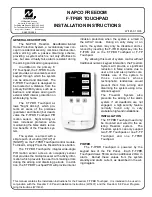
| 7
EN-Rev IM/GN-BM-EU/1.8 Copyright © March, 2021. CSI Solar Co., Ltd.
www.csisolar.com
Canadian Solar bifacial double glass modules have
been certified as Type 3 or Type 13 according to UL 1703,
Type29 according to UL 61730 and as Class A or Class C
for fire performance according to IEC 61730-2 for fire
class performance, please refer to the datasheet or the
product nameplate for the detailed types.
Consult your local authority for guidelines and
requirements for building or structural fire safety.
UL 1703 SYSTEM FIRE RATING REQUIREMENTS
The fire rating of this module is only valid when the
product is installed as specified in the mechanical
mounting instructions.
When installing the modules, ensure the assembly is
mounted over a fire-resistant roof covering rated for
the application.
Photovoltaic systems composed of UL 1703 or UL 61730
certified modules mounted on a UL 2703 certified
mounting system should be evaluated in combination
with roof coverings in accordance with UL 1703 or UL
61730 standard, with respect to meeting the same fire
classification as the roof assembly.
Mounting systems with a System Fire Class Rating
(Class A, B or C), tested in conjunction with fire rated
“Type 2” or “Type 13” or “Type 29” rated modules, are
considered acceptable for use with Canadian Solar
modules, provides the mounting system does not
violate any other requirements of this manual.
Any mounting system limitations on inclination or
accessories required to maintain a specific System Fire
Class Rating should be clearly specified in the
installation instructions and UL 2703 certification of the
mounting system supplier.
ENVIRONMENTAL CONDITIONS
The module is intended for use in general open-air
climates, as defined in IEC 60721-2-1: Classification of
environmental conditions Part 2-1: Environmental
conditions appearing in nature. Temperature and
humidity.
Please consult the Canadian Solar technical support
department for more information on the use of
modules in special climates, such as an altitude greater
than 2000m, heavy snow, severe hail storm, hurricane,
etc.
Do not
install modules near open flames or flammable
materials.
Do not
immerse modules in water or constantly expose
modules to water (either fresh or salt, i.e. from
fountains, sea spray).
Exposing modules to salt (i.e. marine environments) or
sulfur (i.e. sulfur sources, volcanoes) incurs the risk of
module corrosion.
Do not expose modules and their connectors to any
unauthorized chemical substances (e.g. oil, lubricant,
pesticide, etc.), as modules may incur damages.
Failure to comply with these instructions will void
Canadian Solar warranty.
Canadian solar modules have passed salt mist
corrosion resistance test according to IEC 61701, but
the corrosion may still occur on where the modules
frame is connected to the bracket or where the
grounding is connected. Should the installation location
be near the ocean, Canadian solar recommends
stainless steel or aluminum materials be used in the
areas with direct contact with the PV modules, and the
connection point should be protected with anti-
corrosion measures. For more information, please
contact Canadian solar technical support team.
INSTALLATION REQUIREMENTS
Ensure that the module meets the general technical
system requirements.
Ensure that other systems components do not damage
the module mechanically or electrically.
Modules can be wired in series to increase voltage or in
parallel to increase current. To connect modules in
series, connect the cables from the positive terminal of
one module to the negative terminal of the next module.
To connect in parallel, connect the cables from the
positive terminal of one module to the positive terminal
on the next module.
The quantity of bypass diodes in the module’s junction








































